by Dagmara Genda // Sep. 22, 2023
‘five’ is Rindon Johnson’s first solo exhibition at the Berlin location of max goelitz’s Munich gallery. Based on Johnson’s forthcoming novel ‘Clattering’—which imagines a world of alternative intimate and familial structures, where instead of two parents raising a family, society is ordered in formations of five—the exhibition seems to substitute sparsity for concentrated focus. This is unusual for an artist who has shown himself meticulous in his understanding of the layers, intersections and interstices of communication.
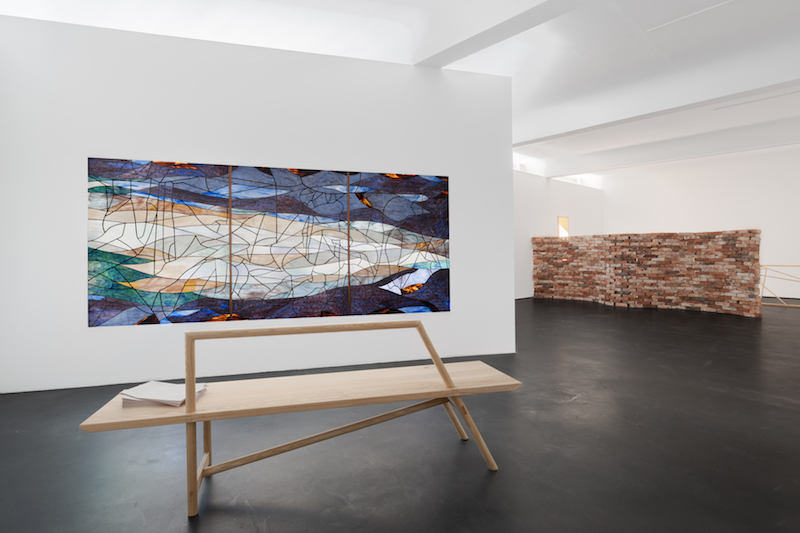
Rindon Johnson: ‘five,’ 2023, installation view // Courtesy of max goelitz, copyright of the artist, photo by Marjorie Brunet Plaza
The show is, according to the press release, based on this still in-process science fiction novel, co-written with Rainer Diana Hamilton, though it features only half of Johnson’s 2021 Pinchuk Foundation installation, where a related video game and a draft of the story was presented in a coil-bound Xerox copied book. At max goelitz, the interactive component is gone and only the first 40 pages are made available for the visitor. Elements of Johnson’s other projects are then added to the mix: a number of paintings on leather, a new five-channel video, a wooden bench and railing, whose design is apparently based on geometric formations governed by the number five, a brick divider, as well as a hole in the wall. While the works are spaced apart to give each one breathing room—not to mention that the gallery itself is rendered an art object through the artist’s architectural interventions—the variety of thought and material results in a lack of rigour that has otherwise proven integral to his exhibitions. This is too bad, because the theme of Johnson’s novel is interesting. It echoes Ursula K. Le Guin’s eradication of gender in the ‘The Left Hand of Darkness’ (1969), even when it lacks the iconic writer’s driven prose and clarity of vision. Johnson’s 40-page news-print excerpt feels indecisive, as if the hard geometric layout is compensation for its dreamy verbiage. Presented with a number of semi-related additions, the overall theme starts to feel watered down.
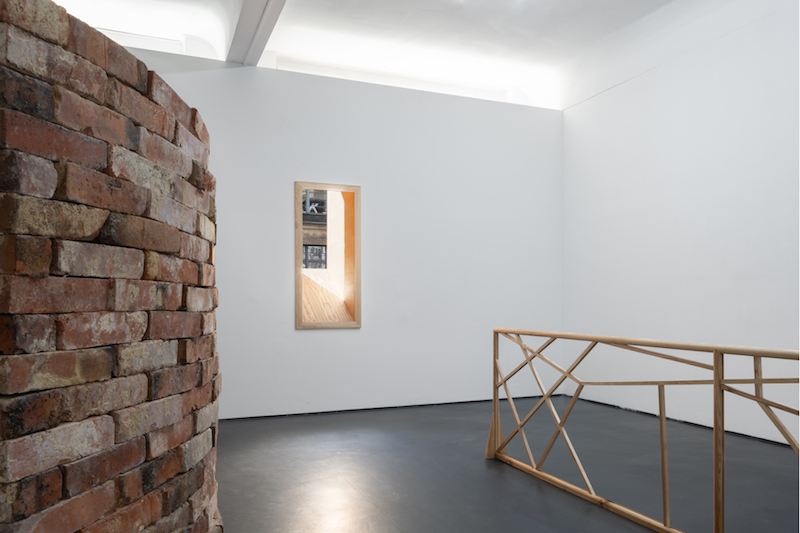
Rindon Johnson: ‘five,’ 2023, installation view // Courtesy of max goelitz, copyright of the artist, photo by Marjorie Brunet Plaza
A scattered effect is not uncommon in commercial galleries, where conceptual compromises often seem to be made in an effort to present a range of new, fresh-out-of-the-studio, pieces. In contrast to many of Johnson’s other shows, this one does not have much media work—just five monitors streaming live from webcams at airports in different parts of the world. They look out of place in a show consisting largely of natural materials and hand-crafted objects. The gallery’s temporary wall blocking two windows has been extended and built out into a corner, on one side of which the stained glass picture, ‘Clattering’ (2021), has been installed. It is resplendently illuminated by the daylight behind it, while in front stands a bench made of bare, untreated wood—a somewhat impractical design object that begrudgingly acquiesces to use. I am told it is made of regionally-sourced ash, produced by local artisans, and its form is meant to echo an arched body. This symbolic and material lineage reminds me of the history-laden narratives used to “enrich” objects into luxury goods, as described by Christian Boltanski and Arnaud Esquerre. It is a marketing technique sourced from art, but one that often seems to echo back into the art world in an increasingly conscious and directed form.
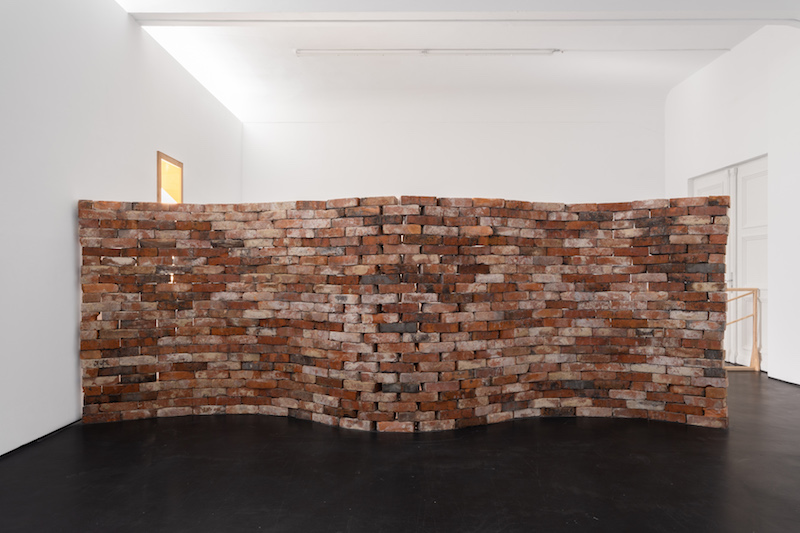
Rindon Johnson: ‘Beyond the pines, pines, pines, pines, pines, hard mountain, enduring, except all the conventions conspire NOTHING BY MOUTH! […],’ 2023 // Courtesy of max goelitz, copyright of the artist, photo by Marjorie Brunet Plaza
Indeed, one can feel the narratives throbbing behind stoically still objects, whose painstaking presentation evokes a kind of domestic air without ever becoming particularly homey; the atmosphere hovers somewhere between a showroom and an under-stated luxury boutique. The wooden ash railing—or perhaps more of a minimal balustrade–that one first encounters when entering the gallery gives the impression of an entrance corridor, through which one is guided, past a curving low brick wall, to be eventually offered a seat in front of the stained glass window. The leather paintings, though hung in the back offices, are also part of the show. They continue a visual theme of domestic furnishing. They are moderately sized; one is a long oval on its side and seems like the perfect mantlepiece, another is built into a structure made of ash whose size and shape echoes a standing mirror. These paintings are smeared with pastel pinks, dark blues and ochre yellows. Compared to the stained glass work, they come off as clumsy. They evoke a cliched abstract expressionism, even as the story of skin that lies behind them leads to the etymologically related concepts of cattle, chattel and capital.
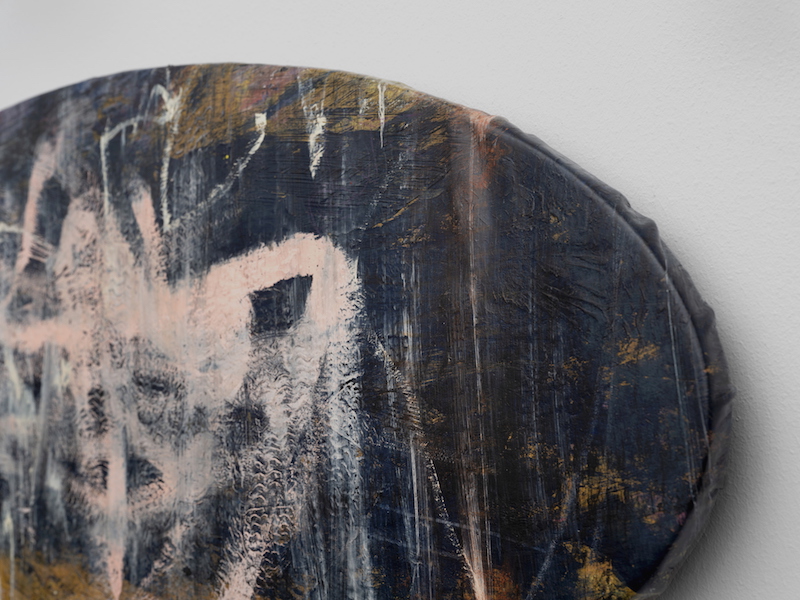
Rindon Johnson: ‘Open: I want it to say, procession. Turn around and have a look at the river. Crocodiles have red eyes at night. Have a look at the river, now pretend you’re me. Now ask yourself.,’ 2023 // Courtesy of max goelitz, copyright of the artist, photo by Marjorie Brunet Plaza
Etymology, the limits of meaning and the relation between words and objects is something often explored by the artist. Johnson’s titles read like poems and, in fact, they often are poems, which is why they have been truncated for the purposes of this review (and can be read in full here). Text and object point to each other’s boundaries, and ultimately to that, which each cannot express. In one particularly long title from a work in ‘CIRCUMSCRIBE’—Johnson’s solo show at Julia Stoschek Foundation in 2019—the artist muses on the problem of labels: “They have attached a particular word to an object or a fact and thereby consider themselves to have appropriated it . . . This is apparent in the space they have not been able to fill with their words.” Indeed, there is lots of space in ‘five’ that escapes words but it does yield to the even more slippery and associative language of form. It is form that blocks the potential connecting threads; they are obscured by brick walls, cut by an elegant balustrade and thwarted by an internet-sourced live stream.
Yet formally speaking, the two “windows” in the show offer me an escape from this meander of meaning. The stained glass evokes another world with its interplay of three discrete layers. One is formed by the planes of coloured and textured surface alluding to landscape. The other is achieved through the lines of various thicknesses that sometimes frame and at other times cut through the undulating planes. These threads hang like a delicate drawing over a painting, simultaneously defining and undoing the image beneath. The third layer is the unseen window illuminating the picture with the constantly changing brightness of daylight.
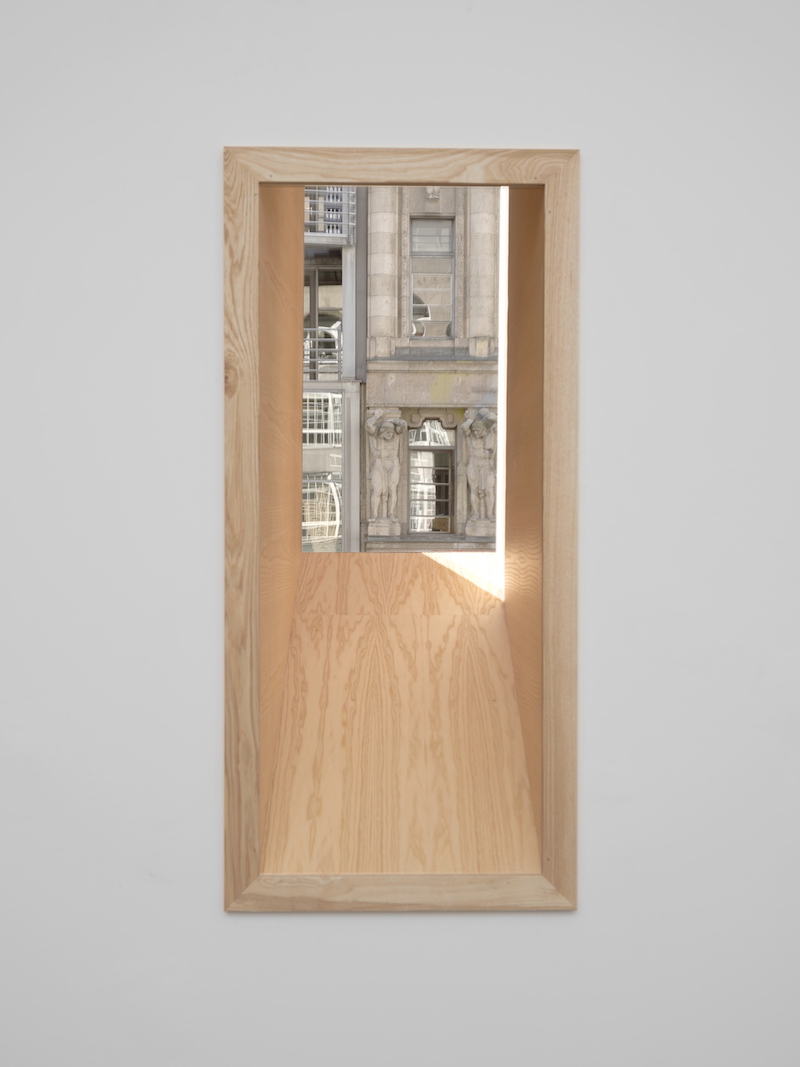
Rindon Johnson: ‘Examples: laughter in the morning and tears in the afternoon. A dreadful boar. — His burning, bloodshot eyes seemed coals of living fire, […],’ 2023 // Courtesy of max goelitz, copyright of the artist, photo by Marjorie Brunet Plaza
The second window is the hole in the wall at the end of the balustrade by the entrance. ‘laughter in the morning and tears in the afternoon. A dreadful boar. — His burning, bloodshot eyes seemed coals of living fire, […]’ (2023) is a a deep wood-framed rectangular opening through which the environment outside, in the form of wind, humidity and noise, intrudes into and colours the gallery space. The hole is small enough, deep enough and so steeply angled, that the framing device becomes its subject. In an inversion of the painting as window cliché, this pseudo-window truly frames the world into an image. Even though it lacks glass—one could crawl out if one wished—its form flattens the view outside. This dramatic cropping of reality re-centres the eye and and focusses it anew.
Perspective is what the two windows in ‘five’ emphasise and offer the visitor. Perspective that is malleable, contingent, fleeting, but not illusory—this is something the artist has often contemplated in pointed, poetic works, but seems absent in Johnson’s current show. This time around perspectives compete at cross purposes, cut each other off and are thwarted by the demands of the gallery exhibition.
Exhibition Info
max goelitz
Rindon Johnson: ‘five’
Exhibition: Sept. 13, 2023 – Jan. 13, 2024
maxgoelitz.com
Rudi-Dutschke-Straße 26, 10969 Berlin, click here for map



















